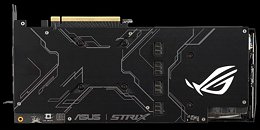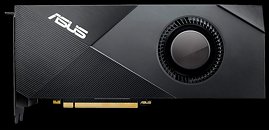Raevenlord
News Editor
- Joined
- Aug 12, 2016
- Messages
- 3,755 (1.23/day)
- Location
- Portugal
| System Name | The Ryzening |
|---|---|
| Processor | AMD Ryzen 9 5900X |
| Motherboard | MSI X570 MAG TOMAHAWK |
| Cooling | Lian Li Galahad 360mm AIO |
| Memory | 32 GB G.Skill Trident Z F4-3733 (4x 8 GB) |
| Video Card(s) | Gigabyte RTX 3070 Ti |
| Storage | Boot: Transcend MTE220S 2TB, Kintson A2000 1TB, Seagate Firewolf Pro 14 TB |
| Display(s) | Acer Nitro VG270UP (1440p 144 Hz IPS) |
| Case | Lian Li O11DX Dynamic White |
| Audio Device(s) | iFi Audio Zen DAC |
| Power Supply | Seasonic Focus+ 750 W |
| Mouse | Cooler Master Masterkeys Lite L |
| Keyboard | Cooler Master Masterkeys Lite L |
| Software | Windows 10 x64 |
ASUS has revealed their entire lineup, interpreting NVIDIA's RTX 2070 silicon (and its TU106 die, a first - remember that **70-class cards previously featured cut-down versions of the full NVIDIA chip). There aren't many surprised here - ASUS has already spent enough R&D in previous years so as to only need to minimally iterate on their designs for each new generation.
The ROG Strix graphics cards sit at the top of the heap, featuring the company's DirectCU III cooling tech (triple fan) in a 2.5-slot design. RGB lighting and dual BIOS support are par of the course by now, as are some of the other features - backplate and metal brace included. Connectivity-wise there are 2x HDMI 2.0b ports, 2x DisplayPort 1.4 outputs, and 1x USB Type-C port for VirtuaLink. The graphics card draws power from the 6-pin and 8-pin PCIe power connectors and will be available in three versions (Gaming OC, Gaming Advanced, and Gaming) according to factory overclocks.




Next up is the Dual lineup, which cuts on some frills and thrills (RGB lighting and one extra fan, for example), increases the thickness of the cooling solution to a 2.7-slot affair, but reduces its overall length. Connectivity is taken care of by 1x HDMI 2.0b port, 3x DisplayPort 1.4 outputs, and 1x USB Type-C port. The Dual too draws power from 6-pin and 8-pin PCIe power connectors and will be available in three versions (Dual OC, Dual Advanced, and Dual Gaming) according to factory overclocks.






Finally, ASUS' Turbo version will be the cheapest option, with the ages-old blower-type cooler design (with a single 80 mm fan) that should be easily outperformed by NVIDIA's own reference cooling solution. It keeps the 2.7-slot cooling solution as the DUAL, adds a little LED bling, and changes little in connectivity: 1x HDMI 2.0b port, 3x DisplayPort 1.4 outputs, and 1x USB Type-C port.




View at TechPowerUp Main Site
The ROG Strix graphics cards sit at the top of the heap, featuring the company's DirectCU III cooling tech (triple fan) in a 2.5-slot design. RGB lighting and dual BIOS support are par of the course by now, as are some of the other features - backplate and metal brace included. Connectivity-wise there are 2x HDMI 2.0b ports, 2x DisplayPort 1.4 outputs, and 1x USB Type-C port for VirtuaLink. The graphics card draws power from the 6-pin and 8-pin PCIe power connectors and will be available in three versions (Gaming OC, Gaming Advanced, and Gaming) according to factory overclocks.




Next up is the Dual lineup, which cuts on some frills and thrills (RGB lighting and one extra fan, for example), increases the thickness of the cooling solution to a 2.7-slot affair, but reduces its overall length. Connectivity is taken care of by 1x HDMI 2.0b port, 3x DisplayPort 1.4 outputs, and 1x USB Type-C port. The Dual too draws power from 6-pin and 8-pin PCIe power connectors and will be available in three versions (Dual OC, Dual Advanced, and Dual Gaming) according to factory overclocks.






Finally, ASUS' Turbo version will be the cheapest option, with the ages-old blower-type cooler design (with a single 80 mm fan) that should be easily outperformed by NVIDIA's own reference cooling solution. It keeps the 2.7-slot cooling solution as the DUAL, adds a little LED bling, and changes little in connectivity: 1x HDMI 2.0b port, 3x DisplayPort 1.4 outputs, and 1x USB Type-C port.




View at TechPowerUp Main Site




